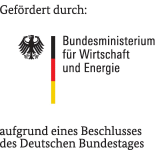In the project, the experimental and computational methods for predicting the characteristic values of azimuthing drive systems where further developed and improved. The focus was better consideration of the gap effects between the propeller hub and gondola as well as the shaft and end plate in the test evaluation, verification of the suitability of quasi-stationary measurements and the analysis of the scale effects on the measurement results.

| Title: | Method development for azimuthing drives |
| Term: | 07/2019 – 10/2021 |
| Project Manager: | Simon Froitzheim (Ulf Barkmann) |
| Founding: | Federal Ministry for Economic Affairs and Energy |
| Project administration: | EuroNorm GmbH |
| Reg.-No.: | 49MF190020 |
The flow around the propeller and the housing was be determined and analysed on two scales by velocity measurements and pressure measurements in the gap between the propeller hub. The velocity measurements in the area of the housing provided information on the flow around the housing and about the interaction between the propeller and the housing. The gap effect between propeller hub and gondola on the pressure in the gap and thus on the internal forces were investigated. Measures to reduce the gap effects where examined. To increase the effectiveness of the model measurements, the use of quasi-stationary measurements for thrusters and podded drives in free-running tests with a constant azimuthing angle and during azimuthing where examined.
In the CFD calculations, the models used must capture the character of the flow around the propeller and housing (turbulent, laminar, transition areas) at the Reynolds numbers of the model test. The previous findings from the calculations with different turbulence models with transition were transferred to the flow calculations of podded drives (propeller and housing). Through systematic calculations with the available turbulence models and comparison with the results of model measurements for different Reynolds numbers and basic turbulence of the incident flow, the parameters for the CFD calculations were determined with good agreement with model measurements. By using hybrid turbulence models, all simulations were carried out in the time domain. The consideration of the gap between the pod and the propeller and the recording of the individual force components made it possible to determine the interaction parameters. The CFD calculations were carried out for free-running thrusters and podded drives as well as for thrusters and podded drives which are quasi-stationary azimuthed.
The transfer of the measured model characteristics to the Reynolds number of the full-scale design is complicated due to the interaction effects between the propeller and the housing. For this purpose, the Reynolds number correction methods for thrusters and podded drives of the SVA and the ITTC were verified by the CFD calculations and geosim measurements. Based on the analysis of the calculations and measurements as well as the predicted change in the propeller and housing characteristics, the applicability of the procedures was reviewed.